C O N T E N T S
In this article we will learn about PN junction diode and it’s characteristics as follows:
- What is PN junction diode ?
- Definition of PN junction diode:
- Working Principle of PN junction diode
- Properties of PN junction diode
- Circuit and symbol of PN junction diode
- Equivalent Circuit of PN junction diode:
- PN junction Current flows
- Ideal current-voltage relationship
- PN junction Characteristics
- Diode quasi-fermi levels
- Applications of PN junction Diode
What is a PN junction diode?
Definition of PN junction diode:
“A pn junction diode is two-terminal or two-electrode semiconductor device.“
“A diode is called as P-N junction diode if it is formed by P-type on one side and N-type on the supplementary one or reverse direction.”
“The diode has to be in forward biased condition to permit the electric current flow. through it.“
- If a positive voltage is connected to the P terminals, the current then pass through from the P to N region as positive voltage helps to cross the depletion region. When we use a negative voltage is applied to the p-type, the depletion zone increases and prevents the current from flowing.
How does a PN junction Diode work?
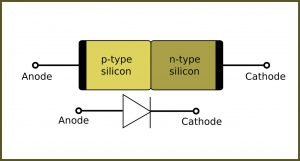
Working Principle of PN junction diode:
In a PN junction Diode, we will consider the p-n junction with a forward-bias voltage employed. We can determine the current-voltage characteristics. The potential barrier of this p-n junction is reduced when a forward-bias voltage is applied to it. It will allow e- and hole to leak through the space charge region.
When holes begin passing through the p region throughout the space charge area, they get excess minority carrier namely, hole and extra minority carrier from drift, recombination and diffusion process.
Likewise, when electrons in the region initiate flowing through the space charge region to P. They get surplus minority carrier electrons.
When semiconductor apparatus with p-n junctions are employed in linear amplifiers, as an instance, time-varying signs are overlaid on the dc currents and voltages. A tiny sinusoidal voltage apply to on a dc voltage applied across a p-n junction will initiate a small-signal current.
The proportion of the current to voltage generate the small-signal admittance of this p-n intersection. The admittance of a forward-biased p-n intersection includes both the conductance and capacitance parameters.
What is the PN junction current?
When a forward-biased voltage is applied to a p-n junction, a current gets generated in the device. That is known as P-N junction current.
Define the ideal current-voltage relationship:
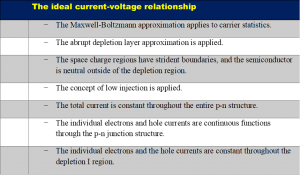
Ideal PN junction current:
The ideal current at a p-n intersection relies on the important components of the fourth principle mentioned previous section. The total current at the intersection is the summation of these electrons and hole currents, that stay steady through the depletion area.
The gradients from the minority carrier concentrations create diffusion currents, and because we’re considering that the electrical field to be ‘0’ at the space-charge edge, we can ignore drift current for minority in this approach.
Equivalent Circuit of PN junction diode:
The small-signal equivalent circuit of the forward-biased p-n junction is derived from an equation.
Y =gd+ Jωcd
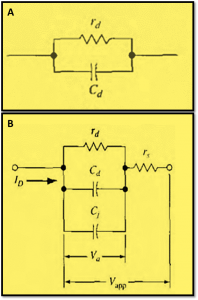
It is required to add the junction capacitance in parallel to the diffusion resistance (rd) and diffusion capacitance. The last element for the equivalent circuit is a series of resistance. The neutral n and p regions have a ‘C’ numbers pf resistances, so the actual p-n junction includes a series resistance which complete equivalent circuit is represented in above Figure.
The voltage through the actual junction is – Actual voltage (Va), and the total voltage applied to the p-n diode is specified by (Vapp) So the expression for the ideal condition as follows:
Vapp = Va+Irs
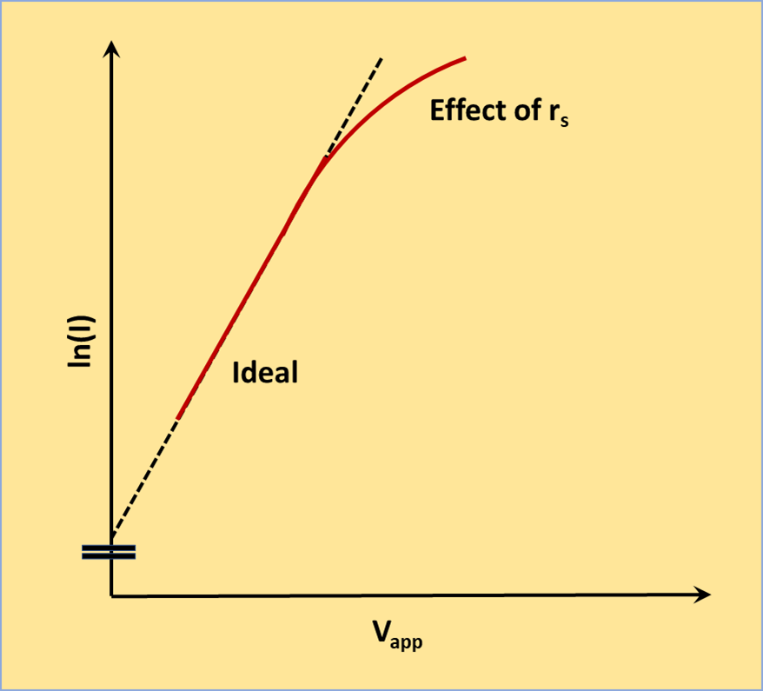
The above figure is V-I characteristics that reveals the impact of the series resistance. A voltage, that can be greater in general, is needed to find the exact same present value when a streak of immunity is included. In the majority of the diodes, the show resistance will probably be negligible.
In certain semiconductor apparatus with p-n junctions, but the series resistance will belong into some feedback loop.
Reverse Biased Recombination Current:
If a PN junction diode is in reverse biasing, It was learnt that mobile holes and electrons were wiped from the space-charge section. The negative signal explains a negative recombination rate; therefore, we’re actually generating electron-hole pairs inside the reverse-biased space charge region.
The recombination of excess holes and electrons at the procedure during the attempt to re-establish the thermal balance. Considering that the concentration of holes and electrons is essentially zero at the reverse-bias area, holes and electrons become generated through the trap level, which also attempts to revive the thermal balance.
Since the holes and electrons are generated, they are trapped from the space-charge area by the electrical field. The flow of charge is at the current direction of a reverse-biasing. This reverse-bias production current, which is principally a result of the creation of holes and electrons at the space-charge region, is added to the reverse-bias ideal saturation current.
Forward Biased Recombination Current:
For a reverse-biased PN junction, electrons and holes are cleared up mostly from the Space charge region. Under forward bias, however, electrons and holes are injected across the space charge region; during that some extra carrier charges may be at the space charge region.
There are certain possibility exists that some of these electrons and holes will recombine also during that time.
Diode quasi-fermi levels
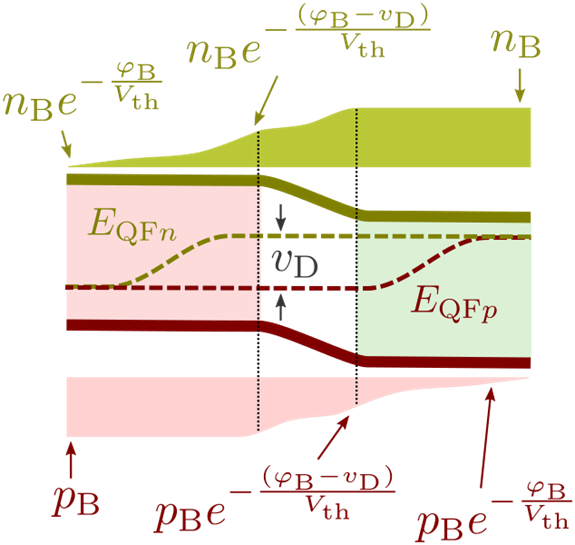
Image Credit: Brews ohare, Diode quasi-fermi levels, CC BY-SA 3.0
What are the uses of PN junction, diode?
Important applications of PN junction diode:
The critical applications of PN junction diodes are:
- PN junction diode can be used as photodiodes.
- PN junction diode can be used as solar cells.
- The forward biased PN junction diode is used as LED.
- PN junction diode used as rectifiers in voltage-controlled device in varactors.
To know more about diode click here

Hi, I am Soumali Bhattacharya. I have done Master’s in Electronics.
I am currently invested in the field of Electronics and communication.
My articles are focused on the major areas of core electronics in a very simple yet informative approach.
I am a vivid learner and try to keep myself updated with all the latest technologies in the field of Electronics domains.
Let’s connect through LinkedIn –